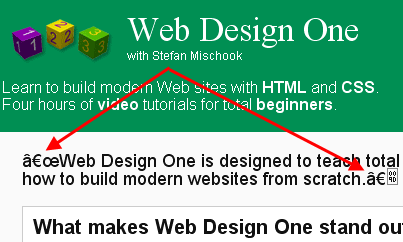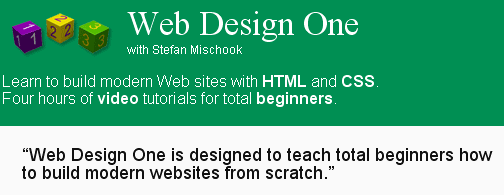SEO Tip: Geo Targeting your Web Server
January 27, 2010
Hi,
In this video I reveal a very important fact that will impact on your traffic .. something I learned first hand!
Check it out:
Thanks for watching,
Stefan Mischook
www.killersites.com
Hi,
In this video I reveal a very important fact that will impact on your traffic .. something I learned first hand!
Check it out:
Thanks for watching,
Stefan Mischook
www.killersites.com
Hi,
In the following video, I talk about the skill-sets that modern web designers need to know.
Let me know what you think. Oh yea, a high quality version of this video can be found in the killersites university.
Stefan Mischook
www.killersites.com
Hi,
I occasionally use email questions sent to me as the basis for a quick article; this time around I had a question about Drupal:

Just enjoyed your website introduction video. I am a senior but am still a regular producer of ads books and booklets for my church, having been a printer all my life. A member has set up a Drupal site – I have been asked to ‘smarten it up’ – I am new to it but I don’t see to prospect of arriving at a graphically attractive site from that program. I think I would be better suggesting we start afresh and build our own site.
What do you think?
Kind regards
John
Hi,
This is just going to be a quick blog post, because I am still busy getting killersites.com up and running properly after an emergency server move I had to make.
The short story …
I had been using the same hosting company for many years and generally with not too many issues. But in the last year, things started to go downhill fast. The server was very slow (overloaded) and it went down way too often.
The last straw that broke my weak nerd-back, was a complete shutdown of my account by some pencil-necked twit who decided that killersites.com had too much traffic … so this no-nothing nerd suspended the account!
… You have to understand, I had been with these guys for 5-6 years, I’ve spoken to the founder/owner on several occasions and they used killersites.com as a feather in their cap:
‘… we proudly host killersites.com.’
So this unannounced shut down of the entire site was shall we say, vexing.
When it get’s that bad, it’s time to leave fast!
A quick threat of legal action got the site back up quickly, but I was warned killersites.com had too much traffic and I had to move it. So, I moved it to our own dedicated servers right away … within hours.
So why did I not change over to our own dedicated server years ago?
Answer: Configuration.
Killersites.com has been around for about 13 years now and it has a lot of old legacy stuff floating around. Specifically, we are talking about old Perl scripts and a couple of Java based web applications.
… Once you get these sort of things working, you’d best leave them alone. That hassle combined with my general laziness caused me to keep killersites.com sitting on the old server, even when some early evidence of trouble started to brew. You can’t underestimate laziness!
Continued trouble …
So as I write, I have still to get the old Java forum up and running again and the Perl based directory is not fully operational. The nice thing though, is that all the PHP based applications:
– WordPress blogs
– Newsletter script
– PHP based forum (to replace the Java created forum)
… migrated easily and are working fine. Once again, no hassles with PHP and I highly recommend you learn PHP as a web designer.
Bye for now.
Stefan Mischook
www.killersites.com
I recently had this question put to me:
Hi Stefan,
I found your article while doing a search about sitemaps, so I figured I’d see what your take on it is.
I work at an agency that does small business websites, some as small as 5 or 6 pages, like an online brochure. I know sitemaps are useful, and help with SEO, but it’s part of our standard design to put text links to each page in the footer of each page. I think a sitemap page with 5 links on it is kind of silly, and a waste of space. Should we continue with the sitemaps or do the footer links suffice in those cases?
Thanks a ton!
I agree. Sitemaps are really useful when there is a lot of content in a web site – if you have a really simple site, it is probably overkill.
There are plenty of articles on how to build an e-commerce website. The problem is that they speak to web-nerds and not to the business people who want to build on online business.
This article speaks to those not so tech savvy entrepreneurs.
What we want to do:
The goal is to create an e-commerce website that builds a business using all the cheap and free tools available in the market today. One great thing about the nerd driven computer revolution, is the strong sense of community and desire to give opportunity to the masses.
Because of this freely available cheap and/or free technology, it is just so much easier today to start a business than it was just 15-20 years ago.
These are some of the questions this article will answer:
Hi,
Have you ever loaded up a web page and found funny looking symbols in your text where there should just be normal text? Take a look at this screen capture:

Those funky symbols are appearing because you are using symbols (in your web page) that fall outside the normal character space range … you need to tell your browser you want to use international symbols.
To do this, you need to add the UTF8 meta tag:
<meta http-equiv=”Content-Type” content=”text/html; charset=utf-8″>
And this is what you will get:

Hope that helps.
Stefan Mischook
www.killersites.com

Hi,
I’ve been using Paypal to process my credit card orders since 2001 and overall, it’s a pretty good service.
… In fact, I would argue that Paypal is essential for just about any e-commerce site since it is used by so many merchants and most importantly, just ordinary people.
Paypal’s main advantages are:
Hi,
I’ve been a advocate of website templates in commercial web design for years now, because it saves the designer a lot of time and in saves the clients a good chunk of cash.
… There are occasions where from-scratch custom design makes sense, but for most web design projects, templates are a great solution – especially with a little customization to make it look unique.
How to use Templates in the Web Design BUSINESS process?
I was recently asked by a web designer how I would show clients the templates that are out there? Do you send them to a template site (free or commercial) or do you do something else?
Hi,
This will be just a short post.
Someone recently wrote to me, frustrated about their web site, where the project seemed to never end … there was always something more to do. Basically, this person was wondering if they were up to being a web designer since they just couldn’t get it right the first time.
Web Design is an Iterative Process
The point of this quick little blog post is to remind you that web design is typically an iterative process. What I mean by that, is that a web site is oftentimes, built in stages where you ‘finish’ the design from a-z and then, you go back and polish the layout and the structure of the site in a second, third and sometimes even a forth pass.
… So don’t get too flustered if your site is not turning out exactly the way you want the first time you take a crack at it. Eventually, you will get it were you want it to be and then … it will be time to redesign again!
Stefan Mischook
www.killersites.com